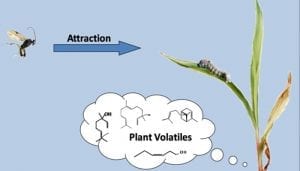News
Researchers Identify Genes for “Help Me!” Aromas from Corn

When caterpillars attack, corn plants release volatile scent compounds that attract parasitic wasps, whose larvae consume the caterpillar from the inside out. (Image courtesy of Annett Richter)
When corn seedlings are nibbled by caterpillars, they defend themselves by releasing scent compounds that attract parasitic wasps whose larvae consume the caterpillar—but not all corn varieties are equally effective at giving the chemical signal for help.
Researchers at Martin Luther University Halle-Wittenberg in Germany, Cornell University and the Boyce Thompson Institute (BTI) used 26 corn varieties to identify genes responsible for sending out this “Help Me!” signal to parasitic wasps. Their study, published in The Plant Cell, fills in several gaps in our knowledge of the enzymes that generate these scent compounds, which are called terpenes. By breeding for the most effective genes for terpene production, breeders could develop corn varieties that are better able to protect against caterpillar attacks.
“This research very nicely demonstrates how collaboration among scientists with diverse areas of expertise, ranging from genomics to small molecule chemistry, can lead to new insights into plant defensive metabolism,” said BTI Professor Georg Jander, a co-author of the paper.
Tender, young corn seedlings don’t have thick stalks and fibrous leaves to defend themselves, so caterpillars, including the cotton leafworm, beet armyworm, and other pests, can do tremendous damage to a farmer’s field. After larvae damage the leaves of seedlings by feeding, the plants begin to synthesize a mixture of terpenes that have strong aromas. Parasitic wasps learn to recognize these chemicals as the smell of nibbling larvae and descend to lay their eggs in the caterpillars’ bodies. After the young wasp fatally consumes the caterpillar’s internal organs, it emerges from the body. In field experiments, the targeted release of terpenes around corn plants reduces damage from hungry caterpillars.
Annett Richter, the lead author of the paper, and now a postdoctoral scientist in Jander’s lab at BTI, tested different varieties of corn and found that they produce terpenes in a range of mixes and quantities for defense. She did this work as part of her doctoral research with senior author Jörg Degenhardt, at Martin Luther University. With the help of scientists in the lab of Ed Buckler, a Cornell Professor and USDA–Agricultural Research Station scientist, the researchers examined the genomes of 26 corn varieties to look for genetic links to terpene production and mapped them to their locations on the chromosomes.
Using genes from these chromosomal regions, Richter identified three new enzymes that function in terpene synthesis pathways to produce linalool, nerolidol, and other terpenes. Besides being useful for corn defense, linalool is a common ingredient in perfumes and cosmetics because it has a floral, citrusy scent.
“With this information we have done a mapping analysis, so we can find out which gene is important for which volatile,” said Richter. “It’s interesting to know where those genes are localized, because then you can cross that variety to lines that are not able to produce them.”
Now that the question of which genes are responsible for which terpenes, Richter will move on to the study of how these genes are regulated. With a better understanding of the genetics and regulation of terpene production, researchers can use breeding to improve these traits in different lines, to create more caterpillar-resistant corn.
“The aim is to improve the volatile signals of their natural defenses, and now breeders have the opportunity to use those defense genes.” said Richter.
Research reported in this news release was supported by the German Research Foundation, the U.S. National Science Foundation (grant numbers IOS-0820619, IOS-1238014, IOS-1139329 and IOS-1339237) and the U.S, Department of Agriculture-Agricultural Research Service.

